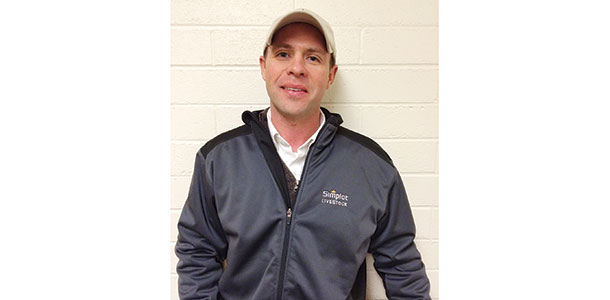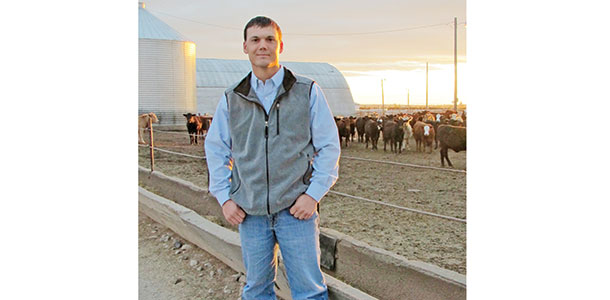
Randall Raymond, DVM, director of research and veterinary services at Simplot Livestock in Grand View, Idaho, says in their feedlots the hospital is a place for cattle to be assessed and treated with as little disruption as possible.
“In the past few years, we have changed the way we manage those hospital pens. Historically, we would keep cattle in hospital pens for several weeks so they could receive a series of treatments and be prepared to go back to their home pens. We don’t do that anymore, for several reasons,” he says.
“One is that hospital bunks are very difficult to manage because of the varying head count as cattle come in and out of the hospital system. Keeping feed fresh in this environment is challenging.
“Second, hospital pens are a good place for sick cattle to transmit diseases to each other. Third, the antibiotics available today last longer and don’t require us to handle cattle multiple times.
Several drugs have seven-day to 10-day tissue levels. This gives us more flexibility and we can often just treat those animals and take them back to their home pen,” he explains.
“Our philosophy is to take sick cattle to the hospital pen to treat them and hope to take them back to their home pen within 24 to 36 hours. Cattle that need extra care or additional treatments are allowed to stay as long as necessary. So we have two kinds of hospital pens,” he says.
“If, when the animals are treated, we think they will be well enough to go home within 36 hours, we put them into the go-home pen. We hope to soon take them back to their normal feed without much social disruption.”
The second type of pen usually has a roof and is well-bedded for more intensive care if animals need to stay multiple days and aren’t as likely to succeed in their home pen social structure.
“If they are injured or extremely lame and won’t do well in a competitive situation back in their normal pen, we’ll keep them in this pen. Hopefully, it will be just a couple days, but they’ll be there until they are well enough to go back and compete,” he says.
“The vast majority end up going home fairly soon. There are always multiple animals coming in at once, just because of the size of the feedyards and number of cattle. The cattle that come in today, for instance, from a certain part of the feedyard will be placed in the same pen.
Then the crews can take that entire pen back to that location when they are ready to go home. That one pen might house cattle from five or six different alleys in that part of the yard. They will be taken back as a group to that region and then sorted back into their normal pens,” Raymond says.
“We try to keep these pens lightly stocked to minimize commingling stress, sorting labor and feed management challenges. Keeping fresh feed and water in these pens is very important, making sure the water tanks are cleaned regularly.
For drug response to be favorable, the cattle must be comfortable and not stressed with a place to rest and get back on feed.”

PAC systems
Corbin Stevens, Stevens Veterinary Services, Production Animal Consultation (PAC) in Scott City, Kansas, is one of seven consultants in this practice. “Depending on size of the yard, we break hospital pens into typical populations for each yard.
Some of the larger feedlots have four or five different hospital locations,” he says. This facilitates ease of getting cattle from various areas into a hospital pen and helps the crew organize cattle into smaller groups.
“We have a four-day recovery system with four recovery pens. I like to set those up so we can actually exercise the cattle each day, moving them into a new pen,” Stevens says. Doing this prevents cattle from getting “stale” as they’re moved into a new pen daily, a new environment, with fresh feed and water.
“On the fourth day, they are evaluated regarding whether they can go back to their home pen, need re-treatment or should go to a convalescent area for more time. Those cattle are sorted once a week to take out the ones that can go home.”
These cattle don’t necessarily need any more drugs or antibiotics, just more time and maybe supportive care like drenches or vitamins, he adds. More time helps them compete with the animals in their home pen at the feedbunk.
“We also have an everyday treatment pen where cattle are brought in for specific ailments they need daily treatment for. Every hospital also has a chronic pen where the animals will either be eventually euthanized or railed – sold on the rail once their drug withdrawal time has been met. Most of our hospitals are set up as a seven-pen system if space is available,” he explains.
“I consult with 15 yards, and they each have a little different system, pen availability and capability regarding the doctor treating the cattle, and a little different management style or feed strategies.
I spend a lot of time evaluating the hospitals and making sure they are utilizing the space available and the treatment protocols – and the expertise to get those cattle home again. We don’t want them in the hospital too long,” says Stevens.
“In some of the populations, when we have heavy pulls for respiratory disease, we identify the animals with a treatment tag, and then take those home the same day and monitor them in their pen.”
The flow-through pens are a big help in speeding recovery. “Antibiotics are a great tool, but if the other important things are not managed properly (animal comfort, minimizing stress, etc.) in the hospital pen, the antibiotic is almost irrelevant.”
It is important to clean water tanks daily. “We want cattle in hospital pens to have fresh water all the time. We Clorox some of the tanks in some yards every day so there won’t be diseases transmitted through the water. Cattle love fresh water and will drink more and stay hydrated,” says Stevens.
“In the winter, we are meticulous about providing dry bedding. We straw them down and keep cattle as comfortable as possible. In summer, many yards are starting to provide portable shade. This seems to help reduce stress,” he says.
“In these hospitals, I also teach cattle handling. How we handle cattle – from the time we decide to pull them out of their home pen – is critical. We take them slow and use positive motion, pressure and release techniques, and no hot shots unless absolutely necessary,” he says.
Using good cattle psychology is important. “Where we are able to exercise them, this is huge. In a human hospital, they want the patient up and walking to increase blood flow and improve healing. It’s the same with cattle; if they just lie around and do nothing, they won’t heal nearly as fast. Some give up if they don’t get up and around.
“It’s amazing how a little exercise helps. The ones that are going to recover quickly may not need it; they just need some antibiotic and they’ll be fine.
But those with a more severe pneumonic lung need something to look forward to. Some of those cattle, after you get them up for exercise, the next day will be waiting at the gate. They want to be out of that hospital pen; it gives them a psychological lift,” he says.
“When we rotate the cattle through the recovery system, we bring them out the back alley, down the alley, open the next gate and bring them into the next recovery pen,” says Stevens. It’s a new pen, new feed and a fresh start for the animal.
“Each day, the cattle feel better, start eating more, and this entices them to be inquisitive – which helps their recovery.” They are not just focused on their own internal misery but curious about what’s happening around them. ![]()
Heather Thomas is a freelance writer based in Idaho.
PHOTOS
TOP: Cattle in feedyard
MIDDLE: Randall Raymond, DVM, director of research and veterinary services at Simplot Livestock in Grand View, Idaho.
BOTTOM: Corbin Stevens, Stevens Veterinary Services, Production Animal Consultation (PAC) in Scott City, Kansas. Photos courtesy of Randall Raymond, Corbin Stevens.








